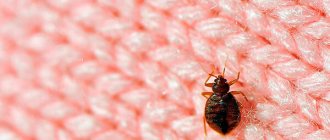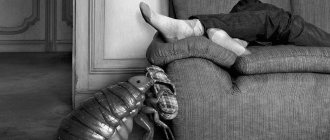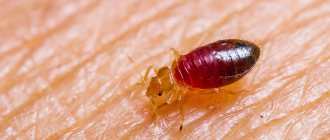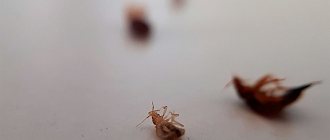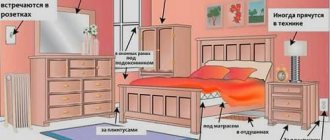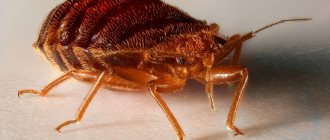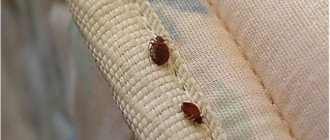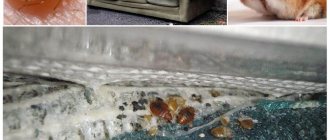This type of insects, such as bugs or hemipterans, is the most numerous order among pests and is widely distributed throughout the planet. There are about 50 thousand varieties of them in nature. Bedbugs especially breed and develop in tropical countries. The main part of bedbugs are terrestrial; they live in the soil, on various parts of plants, in forest litter, etc. What do forest bugs eat? Many experts have studied this issue and come to the conclusion that their food is the juice of all kinds of vegetation (depending on the type of insect). This group of bugs includes insects that harm agricultural and wild plants, for example, turtles and stink bugs.
Rare species of insects have chosen to live in the water element. These are swimmers, rowers, water striders, smoothies, and water scorpions. There are forest bugs that prefer to feed on the juice of other insects and their larvae. The main group is parasitic bedbugs. They attach themselves to the animal's body and live on it for a long time, feeding on its blood. Man is no exception; in houses and apartments you can find bed bugs that live in linen fabrics and feed on the blood and scales of human skin. We can talk for a long time about how bed bugs appear, but this certainly does not depend on the order in the house and the quality of sleeping accessories.
[edit] Who is he and why is he dangerous?
| Dunno decided to follow the advice of the Shrew and stretched out on the shelf without taking off his clothes. Soon he felt that some small animals had attacked him and began to bite him mercilessly. Dunno scratched himself, tearing his body almost to the point of bleeding, but this did not help. “You’d better not itch, brother,” Flexible advised him. “If you scratch your body, they’ll start biting even more.” Bedbugs are very sensitive to the smell of blood. “You said that the bedbugs were burned along with the mattresses,” Dunno grumbled. - So what? Those were burned, and new ones were created. Anyway, there are fewer of them now. You just can’t imagine, brother, how many of them there used to be. Now grace! You just have to be patient a little at first, and then they will suck blood and go to bed. Bedbugs need to sleep too. |
| N. Nosov, “Dunno on the Moon” |
A bedbug in its natural habitat
This animal itself is not dangerous in any way until the concentration of its population in your living space reaches one female individual. That's where it all started. This individual, with a successful operation of sucking your blood, can lay up to 5 eggs at a time, from which creatures will later hatch that want blood from the first second of life. During her life, the female expels up to 500 eggs, which clearly shows the scale of the fucked-up thing. By the way, newly hatched bugs are completely transparent and become visible only after drinking your blood. This makes the process of detection and exterminatus of these almost impossible. There is no evidence yet that bedbugs carry any diseases, but this is not the main thing.
Yes, my young friend, after the second week of scratching your skin all over your body, you will begin to think about suicide, and every time you lie down in a cozy bed, you will realize that at night you will turn into a feeder for an army of bedbugs. Psychological trauma, however. By the way, hands and feet are often scratched to the point of ulcers.
In addition to domestic and other scabies bugs, there are also species that are less aggressive towards humans. However, as a rule, they are all distinguished by their ability to smell. Chskh, the smell persists for quite a long time. Raspberries, for example, which were once “sat” by a bug, acquire a very specific taste. But in Vietnam, the liquid secreted by giant water bugs is added to soup for flavor.
German entomologist Karl Frisch writes a lot of interesting things about the subject:
| Most of the bedbugs, whose lives we just took a quick look at, have wings and use them skillfully. The bed bug has no wings, they have turned into useless stumps. These insects forgot how to fly, and although nature eventually curbed their flying habits, it can be seen in each new generation of bugs that they still tend to form wings today. However, their instruments of flight develop no more than to the point of useless rudiments. But the better they use their legs. To satisfy their hunger, these insects require a person as a victim, whom they persistently search for. As soon as they are satisfied, the insects return to their shelters. A well-trodden path leads them from here, from secret holes, to the place where people sleep, and then back. They hide preferably in the grooves and crevices of beds, frames, wall cladding or on sections of walls hidden under torn wallpaper. Bedbugs prefer peace and darkness and therefore most often attack sleeping people. For this reason, they usually nest somewhere near the beds, so that night flights are not too tiring for them. When hungry, they become capable of making quite long marches. If a house infested with bedbugs is completely abandoned by the inhabitants, then eventually the bedbugs leave it in droves, and you can even see them moving along the walls of the house in search of a place that can become a new springboard for them. In cases where hunger is especially strong, they, neglecting the usual aversion to light, are able to present the observer with a rare spectacle. And he sees how the bugs, in the full brilliance of the sun, enter his apartment through the open window. More often, however, these small creatures do not show such activity and settle involuntarily: people themselves bring them to housewarming parties with furniture, frames and all kinds of household utensils. There are other ways to get bedbugs. These insects feed on the blood of not only humans, but also cats, dogs, rats, mice, bats, and rabbits. They also attack starlings, sparrows, and swallows. Chickens or pigeons can also be heavily infested with these parasites. Thus, a chicken coop, a rabbit hole or an empty nest of swallows may well infest the house with bedbugs, and the residents will not even think about where the attack came from. Once I was able to observe how bedbugs moved from an empty dovecote on which the radio antenna mast was fixed. Like experienced tightrope walkers, the uninvited guests moved into the house along a thin wire. If you think about the list of bedbug victims, if you take a closer look at its menu, you will notice that the parasites feed either on animals that live indoors with people, or, in extreme cases, quite close to them. It seems that for bedbugs it is not so much the taste of blood that is important, but rather the conditions in which the victims live. Here connections and relationships are revealed, the roots of which apparently go back to a very distant past. Probably, the innate craving for dry and warm things, even in prehistoric times, made the bug a parasite of the animals listed above, which found permanent shelter or temporary shelter in the caves where people of that era began to settle. Having become a cave dweller, man also turned into a breadwinner for parasites. All subsequent progress, associated with the transition of man first to huts and then to modern houses, seems, from the bedbug's point of view, only to be a modernization of caves. What is important for bedbugs? Dryness and more or less uniform heat. They remain true to this to this day. |
| K. Frisch, “Ten Little Uninvited Guests” |
Where do bed bugs live?
Bed bugs prefer to live near sleeping areas and even in the bed itself. Insects do not build nests like ants, but still live in crowds. Their lair is an unpleasant sight - large bugs, small nymphs swarming among black feces, discarded shells and eggs.
In addition to clusters, the presence of parasites is indicated by the specific smell of spoiled raspberries, black spots on the wallpaper, and small bloody spots on the sheets. You can find bed bugs in secluded corners of an apartment or house. The most common habitats of bed parasites:
- mattress seams, structural elements of a bed, sofa;
- cushioned furniture;
- inside sockets, household appliances;
- bedside tables, joints of cabinet furniture;
- in clothes, in closets;
- interior items;
- Stuffed Toys;
- cracks, space under baseboards, peeling wallpaper.
Habitats in the house
On a note!
Having identified pests, you should immediately begin extermination of bedbugs through the sanitary service or poison them yourself. For this purpose, it is better to use effective insecticidal preparations in the form of aerosols, sprays, and emulsions. It’s not particularly worth relying on folk remedies for bed bugs. They can only help repel pests for a short period of time.
[edit] Features
Bedbugs love human blood
- The bug is a nocturnal creature. They go out on their forays at night between one and five in the morning. Bed bugs usually attack in flocks of 10-15 individuals. But then it itches as if all 150 had come out.
- Hungry bugs are incredibly flat, making them very difficult to crush even on purpose. The complete opposite is a bug that has just eaten. With any pressure it bursts merrily, splashing your blood around. By the way, not everyone itches fiercely after being bitten by these little vampires. The presence of a subject in the life of such a lucky person can be determined by the many bruises on the bed linen, resulting from bedbugs crushed by him in his sleep.
- Hungry bugs are not only very flat, but also extremely badass creatures that can attack even in the light. Hunger is not a big deal. During a two-week hunger strike, they begin to show ingenuity and dive into the ceiling, from where they will parachute in order to bite.
- If you have already crushed a bug, get ready to smell a disgusting smell, somewhat (except perhaps a unique pungent stench) reminiscent of the smell of “Zvezdochka”. They say that when there are too many bedbugs in an apartment, the smell hangs in the air.
- The bug senses a person by smell and warmth. There is a rumor among the people that cockroaches are the worst enemies of the subject, and there has been a war going on between them for a long time, and if you add cockroaches to a hut infested with bedbugs, you can supposedly watch the movie “Alien vs. Predator” IRL. However, in reality, in such a dwelling you will be able to observe a picture of a joint attack of monsters against humans.
- Paranoia. Yes, get ready for such a bonus. It will always seem to you that a bug ran nearby, that a bug just sat on you, that a bug bit you. And in half the cases this will be true.
- Bedbugs, bitch, are fast. Especially at the peak of activity - at night. One such hungry creature is capable of covering a distance of a meter and a quarter in five seconds. As a consolation, it is worth saying that a pumped parasite will not be able to scuttle as quickly.
- Unlike mosquitoes, which retract once and withdraw, bedbugs have such a nasty property as leaving behind entire dotted lines of bites.
- There has not yet been born an African woman with fertility comparable to our subject. During her life, a female can lay 250-500 eggs. And how these insects love to stare at each other! In 24 hours, individuals can mate 200 times - not like a pathetic two-legged bag of blood!
- And since such a mess started, it’s impossible not to mention that bedbugs are notorious homosexuals and bestialists. The fact is that bed bugs have difficulty distinguishing strangers from their fellows, and among the latter, it is no less difficult to distinguish between males and females. 50% of sexual intercourse is homosexual, and 20% occurs with individuals of other species, such things.
- Our hero’s South American relative, the kissing bug
(so named for its habit of biting people on the lips at night), has an equally annoying feature: after a “kiss,” the bug that has sucked blood immediately shits into the wound, as a result of which a person can become infected with Chagas disease.
What does a house bug look like?
A bed bug is a small insect with a flattened body that accepts only one type of food: blood. The color and size of the parasite vary depending on saturation:
- Black bugs are very hungry individuals that last fed 10-14 days ago, barely reach 4-5 mm in length and are practically invulnerable to mechanical impact.
Satiety - In a well-fed state, the insect acquires a scarlet color and greatly increases in size up to 8.5 mm. If you accidentally move, it is very easy to crush a bedbug that has just finished eating. It is these sluggish representatives who leave blood stains on the bed.
- In most cases, the brown bug is found, since the bright color lasts only a few hours after the feast.
Females are slightly larger than males, and their ratio in the colony is the same. For each “young lady” there is one “gentleman”. Bed parasites are characterized by an incomplete transformation cycle. From the eggs, larvae (nymphs) emerge, the appearance of which is a smaller copy of their parents.
Interesting!
The hatched nymph is white, transparent, and often has a miniature egg capsule cap on its head, which resembles a student’s cap. The color of newborns led to the emergence of a myth that there are supposedly white bugs. However, the larva does not remain in this form for long. Driven by hunger, she goes in search of food and, after satiation, acquires the characteristic bedbug color.
Eggs
[edit] Where do they come from?
A good video from National Geographic with a useful translation.
The answer is simple - from everywhere! If you look at the root, then pedivikia and other respected sources say that the bugs came from caves where they fed on the blood of bats. When ancient people began to explore the caves, the bugs moved in and began to eat not only mice. Thus, the bug has been a human companion since ancient times.
Personally, they may appear for you for the following reasons:
- for example, while you were fucking your classmate Svetka in some dubious house, the locals decided to go on a trip and could very well get stuck in your clothes, which they found by smell;
- if you didn’t visit dubious huts, then Svetka could very well be fucked in that hut by your friend Vasya and bring them to your home. While you were listening with your mouth open as Vasya flirted anally with Svetka, the bugs had already found a hole in your hut and away they went;
- monkey house Yes, yes, while serving time in jail for breaking a window or drunken brawl, you’ll make new friends who won’t want to leave. Have you ever wondered why they are called bedbugs?
- from nowhere. Your drunk neighbor could easily convert to Islam. The bugs, having starved a little, decided to change their native land to a more fruitful one, and changed the location through the nearest outlet;
- from old books and magazines. They can sleep between the pages for years. They can also get to you through library books.
If you, %username%, live in a hostel, then cohabitation with these insects is almost 100% likely to brighten up your drab everyday life.
Notes
- Striganova B. R., Zakharov A. A.
Five-language dictionary of animal names: Insects (Latin-Russian-English-German-French) / Ed. Doctor of Biology sciences, prof. B. R. Striganova. - M.: RUSSO, 2000. - P. 85. - 1060 copies. — ISBN 5-88721-162-8. - ↑ 1 2 Mullen, Gary R.
Medical and Veterinary Entomology, Second Edition / Gary R. Mullen, Durden. - Academic Press, May 8, 2009. - P. 80. - ISBN 0123725003. - Storey, Malcom
CIMICIDAE (bed bugs).
BioImages: The Virtual Field-Guide (UK)
(unavailable link -
history
). bioimages.org.uk. Retrieved May 27, 2010. Archived August 14, 2010. - Family CIMICIDAE. Australian Biological Resources Study: Australian Faunal Directory
. Department of the Environment, Water, Heritage and the Arts (Australia) (2008). Retrieved May 27, 2010. Archived February 23, 2012. - Tarasov, 1996, p. 235-236.
- ↑ 1 2 3 Michael F. Potter.
Bed Bugs.
College of Agriculture, Food and Environment
. University of Kentucky. - ↑ 123
Tarasov, 1996, p. 235. - Robert L. Usinger.
Monograph of Cimicidae (Hemiptera - Heteroptera). - The Thomas Say Foundation, 1966. - Vol. V11. - P. 13. - ↑ 123
Tarasov, 1996, p. 236. - Tarasov V.V. Medical entomology. M.: Moscow State University Publishing House, 1996 – 353 p.
- TRAUMATIC INSEMINATION (Russian) (inaccessible link - history
). Entomologist's Handbook. Retrieved May 19, 2011. Archived June 13, 2011. - Klaus Reinhardt, Michael T. Siva-Jothy.
Biology of the Bed Bugs (Cimicidae).
Annual Review of Entomology, volume 52 pages 351–374
(January 2007). Retrieved May 19, 2011. Archived February 23, 2012. - ↑ 1 2 3 Shestopalov N.V., Roslavtseva S.A., Alekseev M.A., Eremina O.Yu., Tsarenko V.A., Osipova N.Z.
Epidemiological significance of bed bugs and measures to combat them. Information letter // Disinfection business: magazine. - 2012. - T. 81, No. 3. - Ethnographic collection published by the Imperial Russian Geographical Society. Issue VI. p.137, 1864
- Jerome Goddard & Richard deShazo (2009). "Bed bugs ( Cimex lectularius
) and clinical consequences of their bites."
Journal of the American Medical Association 301
(13): 1358–1366. DOI:10.1001/jama.2009.405. PMID 19336711. - ↑ 1 2
Kolb A, Needham GR, Neyman KM, High WA (2009).
"Bedbugs" Dermatol Ther 22
(4):347–52. DOI:10.1111/j.1529-8019.2009.01246.x. PMID 19580578. - (2007) "Insecticide Resistance in the Bed Bug: A Factor in the Pest's Sudden Resurgence?". Journal of medical entomology 22
(2): 175–178. DOI:10.1603/0022-2585(2007)44[175:IRITBB]2.0.CO;2. Retrieved 2010-09-17. - Owen, James
Bloodthirsty Bedbugs Stage Comeback in US, Europe.
National Geographic News
. National Geographic (13 May 2004). Retrieved May 31, 2010. Archived February 23, 2012. - ↑ 12
PMID 19233933 - [1] p.131
- Raj Hulasare, Ph.
D. Fundamental Research on the Efficacy of Heat on Bed Bugs and Heat Transfer in Mattresses (English) (pdf). — “It is important to achieve and maintain temperatures of above 48°C for more than 20 min to effectively kill all life stages of bed bugs. In practice, considering the clutter in the treated space and need to penetrate cracks and crevices, the treatment times are much longer ranging from 6 to 8 and hence 48°C would be highly effective." Archived January 20, 2013. - Instructions for the use of disinfestation agents. OJSC "Preventive Disinfection Station". Retrieved September 11, 2012. Archived September 11, 2012.
- Artamonov V.
Tansy - field ash // Science and life: magazine. - M., 1995. - No. 3. - P. 160. - Stogova N.
Swamp healers Air and Ledum. - St. Petersburg: Peter, 2006. - P. 19. - 96. - (Path to health). — ISBN 5-469-01106-2. - Hahn Jeffrey.
Masked hunters.
Yard & Garden Briefs
. University of Minnesota Extension Service: Yard & Garden Clinic (November 1999). Retrieved May 17, 2011. Archived February 23, 2012. - Encyclopedia Americana. - 1996. - Vol. 3. - P. 413.
- Bio-Integral Resource Center
[edit] How they reproduce
This section is of particular interest, because the reproduction process of these hemipteran vampires is one big lulz. In general, the essence is that the male does not particularly ask whether the female wants sexual intercourse or not. Instead, he pierces the female's shell with his MPH and injects his sperm into the future mother's body.
Males don’t bother much about who they will fuck: a male or a female, so they pierce everyone they see with their reproductive spear, and not necessarily bedbugs. If a male, either by chance or out of love, fucks another male, then a very interesting thing happens: The sperm of the alpha bug mixes with the seed of the passive bug and now the lowered bug carries not one, but two sets of sperm. And at the moment when he fertilizes the female, the probability that the children will look like the father is 1:2.
Now it's time to talk about females. The females of some types of bedbugs are pretty fucked up that their backs will be pierced with a dick. And besides, after each intercourse, a healed scar remains on the back (usually the male’s MPH flies there), which immediately exposes the whore. After much thought, nature resorted to a trick - female bedbugs began to be born with a bunch of pussies on their backs. “What?” thought nature, no one has sex in a real vagina anyway. They appear as light spots on the back and are something of a target for males.
Female bedbugs have a superpower that any woman would definitely want for herself. After she receives a healthy dose of sperm in the back, the female bedbug is in no hurry to fly in, but first thinks about whether she needs it? If the answer is negative and education wins in the debate “child or university,” then the female bedbug will not run headlong to the abortion clinic, but will simply deposit sperm in a special cavity in the body. When the time comes, she will fertilize herself from the snatched seed.
Description
Most bedbugs have scent glands, the openings of which are located in adult bedbugs on the underside of the chest between the first and second pair of legs. The secretions of these glands have a characteristic odor that is unpleasant to humans, it is believed that it repels enemies, and possibly acts as a pheromone. The secretion consists mainly of aldehydes, for example those close to CH3-(CH2)2-CH=CH-CHO, and is close in composition to pheromones.
Some species have developed developed care for offspring and signs of subsocial behavior. For example, females of the Japanese tree bug Parastrachia japonensis
Every day they bring fruits of the
Schoepfia jasminodora
from the olax family to their larvae’s nest[3].
At the same time, other females can steal fruits from the unattended nests of other females of this species. By the end of larval development, up to 150 fruit drupes can accumulate in the nest[3]. Some bugs, such as Phyllomorpha laciniata
, lay eggs on the dorsal side of the male's body, where they remain until the larvae hatch.[4]
[edit] Habitats
Malysheva won’t say bullshit
If, after all, the stars have aligned in such a way that bedbugs have taken up residence in your home, burn down your apartment, don’t despair. First, find all the places where these bastards can hide. Theoretically, they can be everywhere you poke them - their flat bodies are designed to fit into any crevice, but it is worth noting the bloodsuckers’ favorite places.
- Actually, the cracks
- no, not the genitals. We are talking about all kinds of joints and cracks inside your apartment. Somewhere the boards are loose, somewhere the baseboard is coming off. To hide their body, bedbugs only need a couple of millimeters. The probability that the gap will be inhabited is proportional to the proximity of the bed, and indeed any place to sleep, be it a bed or a pissed-off mattress. - Wallpaper
- peeling wallpaper, crooked joints between wallpaper are also good, usable holes. They also like to live on walls in sockets, behind bookshelves, sometimes behind cabinets and behind radiators. - The place to sleep
is a sofa, mattress, bed, or even a folding bed. In almost 150% of cases, this location is the default for bedbugs. It is a strategically correct decision to make the base next to the power source. If you have already read all sorts of passions, then you can right now turn your mattress over and look for traces of bedbugs: A lot of black dots (shit), cocoons and larvae (optional, since they are usually well hidden) and the bedbugs themselves. - Upholstered furniture
- armchairs, ottomans, etc. We look in the joints of wooden frames, or folds of interior upholstery, under wooden armrests/pads, etc. - Clothes
- it is known for certain that bedbugs look for their prey by smell and are not at all above living in your clothes, anon.
The importance of bedbugs in nature and human life
This type of insects, such as bugs or hemipterans, is the most numerous order among pests and is widely distributed throughout the planet.
There are about 50 thousand varieties of them in nature. Bedbugs especially breed and develop in tropical countries. The main part of bedbugs are terrestrial; they live in the soil, on various parts of plants, in forest litter, etc. What do forest bugs eat? Many experts have studied this issue and come to the conclusion that their food is the juice of all kinds of vegetation (depending on the type of insect). This group of bugs includes insects that harm agricultural and wild plants, for example, turtles and stink bugs. Rare species of insects have chosen to live in the water element. These are swimmers, rowers, water striders, smoothies, and water scorpions. There are forest bugs that prefer to feed on the juice of other insects and their larvae. The main group is parasitic bedbugs. They attach themselves to the animal's body and live on it for a long time, feeding on its blood. Man is no exception; in houses and apartments you can find bed bugs that live in linen fabrics and feed on the blood and scales of human skin. We can talk for a long time about how bed bugs appear, but this certainly does not depend on the order in the house and the quality of sleeping accessories.
[edit] Methods of struggle
[edit] Chemical treatment
The issue of exterminating these disgusting creatures should be approached as seriously as possible and not waste money on good service against insects. Everything is clear here, even a fool will understand that it is better to hire a team for three to four thousand wooden ones, which are guaranteed to cut the bedbugs out of your life; Usually such offices provide a guarantee for six months or even a year.
And yes, prepare for the mind-blowing stench of processing. To save money, processors often poison with antediluvian preparations, which are cheaper, but they give off an amber - don’t worry, mother. If they come into contact with the skin or, God forbid, in the eyes, these substances cause severe allergies, including anaphylactic shock. And the population believes that the worse the stench, the better the result (this is not true - the most effective modern drugs have no smell at all). So it is possible that from now on there will be a subtle smell of chemicals in your apartment. Forever. All furniture treated once will smell of chemicals for the rest of its physical existence.
On the other hand, there are modern and quite effective preparations that are practically odorless, almost non-toxic to humans and no less effective, so it makes sense to be a little more careful when choosing a pest control service. In any case, when working even with the most modern means, it is worth using a respirator or at least a gauze bandage, since any chemical in aerosol form has a life-giving effect on the lungs.
Another important point is the need to re-treat the room after about two weeks. Its meaning is that sabzh eggs are extremely resistant to chemicals, and in a couple of weeks a new generation has time to hatch, and the chemicals from the first treatment have already eroded greatly. So, having wasted the right amount of time, you can easily end up with an unplanned continuation of the banquet.
Even Heisenberg can't stand bedbugs
If you don't have money, don't be upset. After a fair amount of fucking, you can get rid of the reptiles on your own. For example, there is such a product as “Dobrokhim-micro”. Such joy costs about 500 wooden ones, but it kills the subject within a couple of days. First, we put everything away: all the dishes and things in bags. We dilute the product with water in the proportion of 3 ml of substance per liter of water and spray everything to hell. By the word “everything” we mean “ in general”
All":
- sofas, beds, couches, mattresses;
- cabinets, bedside tables, bookcases;
- walls, ceilings, door frames, baseboards;
- remove paintings and posters on the wall (at the back), sockets, switches (after disassembling them), lamps and shelves from the wall and process them too;
- tables, armchairs, chairs, stools;
- all household appliances, but carefully
so as not to flood them; - wash your clothes and other rags in boiling water (from the tap),
- and also don’t be lazy and treat your laptop backpack, vacuum the inside of the desktop and check all heat sources. Insect mothers also want a warm and well-fed future for their children.
It is worth paying special attention to the places where subjects accumulate. You need to pour as much solution into the lair of nasty bugs as you can without flooding the neighbors below.
If the procedure is done conscientiously, within a couple of days the bedbugs will disappear into the annals of history. Don’t be upset if the next day you see several bedbugs briskly walking around your living space - this is their last walk.
There is another remedy - cucaracha. Costs 900 rubles. Sold at the local sanitary and epidemiological station
from hands, and does not go to household chemical stores. Dilute the product with water in the amount of 10 ml per 1 bucket (12 l) of warm water. After treatment with this product, you should leave the house for 12 hours.
Exterminator-kun's comment
: in its pure form, cucaracha does not have much effect on bedbugs, due to the low content (10%) of malathion, so it is better to mix it with, for example, “doublet” (45% malathion).
It is better to exceed the dosage on the packages, because it will only affect insects that are spherical in a vacuum and have no resistance. Feel free to add 10-20 ml of the mixture per liter of water, anon. It is enough to leave the hut for 4 hours, then ventilate the hut for 2-3 hours, windows and doors OPEN EVERYTHING AND FULLLY
.
I think there’s no need to remind us about a gas mask, rubber gloves and overalls for car painters (thick and light, that’s all), because we’re not poisoning them with vitamins after all. Either wash linen and clothes at 90 degrees, or treat with steam, especially seams and folds. THE TEMPERATURE FROM THE TAP MAY NOT BE ENOUGH!
Covers from mattresses and pillows too.
If you are too lazy yourself, look for a dry cleaner with a disinfection chamber, they will steam everything for you. After 4-5 days, use a steam generator to treat the seams/folds on the sofa, especially inside and below.
Having previously removed the wooden pads on the armrests, you can appreciate the scale of the tragedy, because bedbugs also love to live under them. Sometimes it is possible to exterminate the creatures using just five cans of ordinary dichlorvos. We disassemble the sofa, remove the carpets, move aside the cabinets, clear out the trash and carefully blow dichlorvos into every suspicious crevice. Several visits - and all that was left of the creatures was a faint smell and dry skins. True, dichlorvos is also not a gift; it is better to carry out the treatment in a gas mask or just quickly get out of the house. You can try karbofos - it is more effective, but, however, also more toxic. And you shouldn’t wait until there are too many creatures; the sooner you start a war, the less likely it is that some creature will survive and give birth to a new army.
There are rumors that smoke bombs are suitable for treating small buildings such as cabins to disinfect cellars. Bedbugs are cut down along with the guest workers living in the cabins. When using a smoke bomb in an apartment, the love and adoration of your neighbors is guaranteed.
Since the time of perestroika, there have been stories about the wonderful properties of hexogen, which sends all the bedbugs from the apartment and the owners after the bedbugs into another world, but a little later, when they have already managed to pay the dashing handlers. At one time there were crazy people who poisoned bedbugs (and a bunch of people) with solid rocket fuel. It might be worth using their experience as a last resort.
[edit] Heat and cool
A surefire method that kills the subject on the count of ONCE. It only works if there is such a bad minus outside the window. Recommended for use in Siberia and Yakutia. The gist is this: a hell of a lot of heaters are brought into the house and turned on at full blast. We heat the hut to 60-70 degrees, then suddenly turn everything off and open all the windows wide open. Bedbugs cannot withstand such a drop (as well as their eggs), and the story ends with a happy ending. Care should be taken to ensure that the pipes in the apartment do not burst along with the bedbugs, and that the wiring does not burn out. There is another way - heat the hut to 50 degrees Celsius for 6-8 hours, after which the bedbugs kill themselves.
There is also an opinion that there are enough bedbugs if the temperature in the room is below −7˚C for 3 days. Also, in Siberia huts were frozen out to remove cockroaches.
[edit] Search and destroy
Classic extermination in French, 1896
The essence of the method comes down to finding each bug by hand and cutting it out the way your imagination wants. If you want, press, if you want, eat.
The most recommended arsenal of weapons in this method is a tea pot and a vacuum cleaner. Then everything is predictable: you look for possible (or known) nests of bedbugs, everything that has the function of being sucked into the vacuum cleaner goes there, the rest is poured with boiling water. By the way, having flown along the vacuum cleaner hose, hitting the valve and getting into the dust collector, the bug can survive, think and think, and crawl back out. So it’s better to immediately take them out of the apartment, or plug the hose tightly.
Option of the thermal method: previously the so-called. bug cookers - a kind of heated watering cans, from which it was possible to water cracks and sofas with poison heated to a boil. But then the bugs made a barrel, made a tactical retreat and created the illusion among the Soviet leadership that they had been exhausted. Therefore, bedbugs were discontinued and have not been produced for a long time, but bedbugs have made a triumphant return. An electric steam generator can be used as a replacement for the bug cooker, but only Cthulhu knows how resistant this machine is to the pouring of chemical poisons into it. You can take an old electric kettle, which you don’t mind getting dirty with chemicals, and call it a Klopovar. Alzo, there is also a Soviet army device “Dezinfal”, which differs from the classic bug cooker only in the absence of a flame pipe (which, however, does not prevent you from heating it on an electric stove). “Disinfal” costs a penny - you pour the same “Cucaracha” into it, heat it on the stove and kill the bugs with life-giving heated “Cyclone-B”.
Such mechanical methods are suitable only for very hardworking and attentive people who like to play hardcore. Because if you miss even one egg, the subject will multiply with renewed vigor, or even more so.
Most likely, this method cannot be used in large rooms, but if you have several slaves of faithful friends who are ready to engage in a monotonous and uninteresting activity for several hours in a row, success is still possible.
[edit] Operation "Holodomor"
Escaping from your native permanent residence for a month or two will not bring results, since subjects can easily endure hunger for up to a year and they don’t give a fuck that you’re hanging out with your relatives. And if the house is an apartment building, the creatures will simply crawl into the neighbors and then return.
[edit] Encapsulation
If some kind of hardwood renovation is flourishing in the apartment, that is, the Soviet tradition of creating a portal to a common subspace behind each loosely glued tile has already been slightly destroyed, you can bring the picture to the absolute, leaving only the ventilation mesh (very small and very steel) and siliconing everything else until completely sealed . After this, poisoning bedbugs is pleasant and easy - they will no longer stay with your neighbors, and the concentration of poison required is much lower: after all, you will then live in this apartment yourself. From the untested - temporarily seal the ventilation too (with tape, for example) and release several large carbon dioxide fire extinguishers or a dozen or two cans of dichlorvos in the apartment, tactically screwing up so that the creatures simply suffocate.
[edit] Baiting with diatomaceous earth
If you don’t want to be poisoned by chemicals or are just a half-hippie, then you can use a cunning method: sprinkle all the habitats of bedbugs, themselves, as well as their paths of movement with diatomaceous earth. It consists of fragments of the shells of long-deceased diatoms (sic!). These remains are stuffed under the bug’s shell, furiously rubbed and cracked, and most importantly, due to their hyperporosity, they are completely dehydrated, which is why the bastard soon dies. It is completely harmless to humans and other domestic animals, if two conditions are met: 1) use a food product; (diatomaceous earth for use in pool filters is mixed with harsh chemicals); 2) do not inhale or use a respirator. However, you can eat it in handfuls; for proofs, you are welcome to the vegetable storehouse, where grain is poured into it, or into a tube of paste, where it is used instead of an abrasive. Spiders, cockroaches, ticks and other sworn arthropod friends of humans react to this exercise just as favorably. But it is worth noting that diatomaceous earth has no effect on pest eggs, and in a damp and humid environment it loses its effect on adults.
[edit] Hydrocyanic acid
“This story happened in the 70-80s, I don’t remember exactly, but now there’s no one to ask. The scene is a separate barracks of the chemical defense academy. A wild number of bedbugs, cockroaches and rats bred in the building. There was no way to get them out. But military chemists found an unconventional solution: all the cadets were temporarily moved to tents at a great distance (this happened in the summer), and several barrels of hydrocyanic acid were raised to the top floor of the building. The windows and doors are carefully caulked. And from a distance of a kilometer, the barrels were shot through the window by a sniper. Three days later, all that was left was to open the building and thoroughly clean it. (Prussic acid disintegrates quickly in air). The method is not recommended for repetition at home." 100% stardom - hydrocyanic acid in barrels at every step only happens in Hollywood films.
Who eats bedbugs in nature?
Bugs that live in forests, fields, gardens and ponds also have their own natural enemies.
Water bugs
Water striders, which themselves are predatory water bugs, are hunted from the air by birds, and by amphibians from the shore. In addition, water striders are threatened by a parasite - a water mite, which, gradually exhausting the insects, leads to their death.
Greblyakov, also living in water, are eaten by larger predatory bugs - smoothies.
Harmful turtle
Of particular interest to humans are the entomophagous (those who eat insects) pest bugs. Scientists pay a lot of attention to the biological control of harmful bugs, the main threat to grain crops.
Some species of spiders that do not weave a trapping web feed on the larvae and adults of bedbugs. Namely, representatives of the family of side-walking spiders (Thomisidae), oxyopids (Oxyopidae) and wolf farts (Lycosidae). In laboratory conditions, a female of one of the species of side-walking spiders destroyed up to 50 first-instar larvae or two adults.
Ground beetles of some genera willingly eat harmful turtles at all stages of its development. Ants, hunting bugs and lacewing larvae are the ones that eat the eggs and larvae of these bugs. Phasian flies destroy the imago.
Telenomines, representatives of the order Hymenoptera, play a huge role in the fight against grain pests. These insects are parasites of cereal bug eggs.
Shield insects
Telenominas parasitize eggs and other bugs from the stink bug family: berry, Italian, tree and others. The larvae of other representatives of the same order (Trissolcus viktorovi Kozl., T. festivae Vikt.), as well as the larvae of the phasia fly, destroy the eggs of cruciferous bugs.
In addition, stink bugs become victims of interspecific cannibalism, as predatory species of bugs feed on them. The species of spiders mentioned above also pose a threat to them.
Let us also include here the cannibal of the horsefly family, Stethoconus cyrtopeltis FI., which is the enemy of the pear bug (or pear laceworm).
Toy soldiers
Intraspecific cannibalism is also observed among soldiers from the red bug family. Especially during the wintering period, when a large colony is compactly located in natural shelters, hungry soldiers can eat each other.
[edit] See also
- Mosquitoes
- Cockroaches
- NOT X
- Clop
- Half a bug, why not?
| [ + ] Bedbugs are fierce enemies of humans! | |||||||||||||||||
| |||||||||||||||||
Which animal eats bedbugs?
Well-known hedgehogs love to eat animal food. Their varied diet also includes bedbugs. Green toads also love bugs, so not only water striders, but also other species are killed by amphibians.
Like many insects, bedbugs serve as food for birds. For example, the Accentor happily eats even bitter bugs. On occasion, various small rodents, such as mice, also eat them.
Cats and some dog breeds are endowed with a hunting instinct, and bedbugs, along with other insects, are of interest to them from this point of view. Having caught a bug, animals usually eat it.
As you can see, among the animal world there are many who are ready to eat bedbugs. In what situations can a person practically use these biological laws? In the fight against bed bugs, the role of its natural enemies, unfortunately, is too insignificant to count on their help.
But there is a powerful army of insects against the formidable pest of cereals. Research into the effectiveness of telenomin in recent years has prompted the agricultural industry to reconsider crop protection strategies and use chemicals more balancedly.
And here's another thing: some bedbugs are actually eaten by people! So in Japan and the countries of Southeast Asia in restaurants you can try the fried water giant, the white bug, as a delicacy.
Sources:
- “Entomophages of grain bugs in grain agrocenoses of the Volga region” S.E. Kamenchenko, N.I. Strizhakov, T.V. Naumova
- “Biological plant protection” N.V. Bondarenko
Representatives of fauna that feed on bedbugs in the wild
In the wild, food division occurs based on the type of bugs. Some representatives of the flora feed on water bloodsuckers, others on soldiers. Let's consider what types of bedbugs and who eats them.
Harmful turtle
This type of parasite causes damage to humans outside the home. Representatives of the species destroy grain crops. Several families of spiders feed on parasites:
Representatives of insects eat both adults and eggs of cereal destroyers.
For reference! A female sidewalk spider is capable of eating two adults or fifty of their larvae at one time.
Several genera of ground beetles eat pests in the field when the turtles sit on the spikelets. Beetles eat individuals at all stages of their development. Phasia eat mature individuals. Larvae and eggs eat:
Telenominas help people fight bloodsuckers. Their role in this matter is very important. Insects eat parasites during the egg development stage. Note! Telenomins annually destroy more than half of the eggs laid by the harmful turtle.
Toy soldiers
Intraspecific cannibalism flourishes among representatives of the red bug family. This behavior worsens in individuals during the cold season. Representatives of the species winter in large groups in shelters. Overwhelming hunger forces them to eat their own kind.
Water striders
Water striders are considered predators. Despite this, they are hunted by several classes of animals at once. Among them there are birds that hunt bloodsuckers from the air. At the shore, water striders are eaten by various amphibians.
Among insects, water mites and smoothies are destroyed and consumed as food. The first representatives of the fauna exhaust the water strider, which leads to the death of water pests. Smoothies eat rowers.
Shield insects
This family is most often attacked because it has a large number of enemies. Telenomines prefer berry, tree and Italian scale insects. They only eat eggs of pests. Cruciferous parasites are preyed upon by phasia fly larvae.
Shield insects are eaten by other predatory species of their fellows. Insects are subject to interspecific cannibalism throughout the year, and not just during cold periods. All types of spiders discussed earlier are also enemies of shield insects. They eat eggs and adults.
Pear lacemaker
Representatives of the species became victims of interspecific cannibalism. They are consumed as food by a family of horseflies. Both adult individuals and the eggs they lay are destroyed.
What are bedbugs afraid of?
It turns out that bedbugs have a keen sense of smell and are very susceptible to strong odors. With the help of special thin hairs - sensilla, bedbugs pick up the aroma from afar...
24984
05.07.2019 12:34
Small blood-sucking parasites cause discomfort with their presence. Many residents have had to suffer from the presence of bedbugs. Their painful bites cause itching, redness of the skin, and sometimes provoke the onset of dangerous pathologies. To get rid of unwanted bugs, you must first find out what bedbugs are afraid of.
